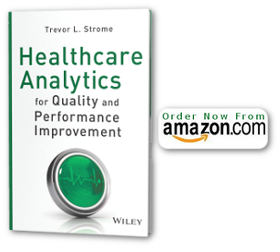Yes it can, according to Christian Chabot, the CEO and co-founder of Tableau Software, developers of some of the most leading-edge data visualization software. In this excellent article by Stuart Miles about the opening of Tableau’s UK office, Chabot states that, “Analytics and stats might sound dull unless you’re an accountant,” but if they’re done right, “they are about empowering us to understand more.”
The three goals of data visualization
Analytics can and should be more than merely presenting datapoints on a boring graph. In the article, Chabot states, “a good graphic should have three goals: Firstly to help the audience answer a question, second to help tell a story, and thirdly to start a conversation.”
These three points are especially relevant to the application of analytics and data visualization in Healthcare, and can help to inspire and energize ongoing quality improvement initiatives. Visualization and analytics tools are definitely used to answer questions all the time (spanning the spectrum from financial and operational performance to clinical quality). Unfortunately, this data is usually lost in boring bar charts or scatter plots.
Visualization makes data relevant to front-line staff
When applied in creative ways that are relevant to front-line staff, however, the visualization of healthcare data can actually help piece together the healthcare quality puzzle. Proper analysis and visualization can turn dozens of individual data points into a cohesive picture of what is working well, and what needs to change, in workflows and other processes. This clarity, in turn, this will spark conversation among front-line staff and quality improvement facilitators that keep staff motivated and focused on continually identifying ways to improve quality of care.
Growing beyond the spreadsheet
As the volume of healthcare data continues to grow, healthcare organizations must grow beyond the spreadsheet. Effective and creative visualization of large quantities of data will be essential to engage all levels of staff in quality improvement initiatives. As the article states, “if you can make data exciting then there is a greater chance of finding the hidden gems within the numbers – “Matrix style” – that current boring spreadsheets are never going to achieve.”
So, not only can your data be cool and engaging, the more engaging the better for healthcare quality improvement initiatives.

{ 0 comments… add one now }
{ 1 trackback }